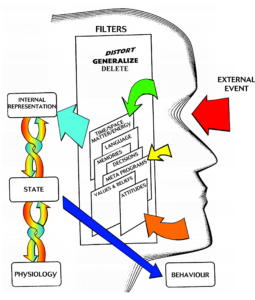According to NLP theory and the presuppositions, the individual is always in communication with inner world and the environment. The model of communication which is adopted in NLP can be presented on the following picture.

The individual receives information from the EXTERNAL IVENTS throw five sense (See, Hear, Feel, Taste and Smell).
NLP study presupposes that each information is filtered form the individual throw the FILTERS (Deletation, Distortion and Generalization). These filters are unique for each individual and they differ depending on individual attitude, values and beliefs, meta programs, decisions, memories, language, and time.
When information from external event will pass this FILTERS the individual crates its own INTERNAL REPRESENTATION (IR) of the event. The internal representation is unique for each individual. The compeonents of Internal Representations are connected with the senses which are used by the individual. More precisely the components are:
Visual representation system (V) – seeing
Auditory representational system (A) – hearing
Kinesthetic representational system (K) – feeling
Olfactory representational system (O) – smell
Gustatory representational system (G) – Tasting
The INTERNAL REPRESENTATION system creates the emotional STATE of the individual which further influence on the PHISIOLOGY (breathing, speaking, movement) and BEHAVIOUR of the individual.
This model shows the understanding the communication in NLP. Understanding the Representational Systems are the base for NLP, since they highly influence the emotional state, physiology and behavior. Main representational systems are Visual, Auditory and Kinesthetic (VAK) and Olfactory and Gustatory (OG) systems are connected with the feelings- Kinestethic.
These IR systems are also known as MODALITIES. They are frequently used in the practical exercises which are basic for practicing NLP techniques.